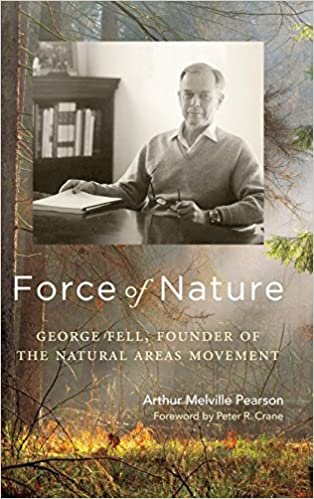Book Review: Force of Nature
Force of Nature. Arthur Melville Pearson. University of Wisconsin Press, April 18, 2017, Hardcover, 216 pages.
Reviewed by Gerry Souter.
For the reader searching for a definition of the word “indomitable,” Force of Natureby Arthur Melville Pearson should prove to be a good read. In a slim volume, Pearson has captured this “force” in George Fell, founder of the Natural Areas Movement. If this organization is unknown to the reader, or Fell’s name does not evoke the image of a naturalist with the street cred of a John Muir, John Burroughs, or Rachel Carson, Fell’s contribution to the preservation of natural spaces is still remarkable.
All of us have encountered patches of woods, streambeds, and stretches of wild prairie grass adjoining suburban housing, bordering industrial parks, or stretching untamed along the edges of plowed fields.
Some of these mini-wildernesses come with an unfamiliar name—a local war hero, beloved crusader, or Civil War battleground emblazoned in weather-proof gilt at a gravel-road entrance. Often, we are crunching past another mini-monument to George Fell.
Yosemite, Yellowstone, the Grand Canyon, Grand Teton, Bryce Canyon, Sequoia and their like rise to the top when American National Parks are mentioned. George Fell embraced the smaller, scattered, and most endangered natural areas. Housing developments, industrial parks, suburban sprawl, agribusiness farms—all important to the economy—are chewing away at the green soul of America’s natural inheritance. Today, after Fell’s often lonely battle for preservation of these wild places, they are now fighting the effects of climate change, living growths dueling greenhouse gasses for the air we breathe.
George Fell’s life began in the 1920s, but his education sparked to life when he discovered natural conservation where “conservation means harmony between men and the land,” as voiced in Aldo Leopold’s 1939 book, The Farmer as Conservationist. When the wartime draft began, Fell had already committed his efforts to nature preservation and signed up as a Conscientious Objector, working in a Civilian Public Service Camp in Germfask, Michigan. Even there, he felt constrained with work he felt had little national importance. During the years following World War II, a victorious America struggled to regain its peacetime economy while shaken to its social, political, and cultural roots. We had won the war, and winning the peace meant expansion and development. Mining, planting, and building took advantage of our greatest heritage, open land for the taking. Land conservation had a low priority.
Pearson’s narrative follows Fell’s struggle to raise national awareness of the need for open land beyond the spectacle of our federally managed national parks. In Illinois, he found traction with the state government as the Illinois Department of Conservation anointed projects such as the Illinois Beach Nature Preserve. During the start-up of the Nature Conservancy, he and his wife spread out their preservation efforts nationally. They traveled across the country, searching for green spaces and wild land patches to protect.
Fell’s single-mindedness pressed forward his goals, even as political and economic forces objected. A quietly relentless warrior, Fell’s presence on land development boards sucked the air from the room as he built his arguments, based on passion and bulwarked by logical common sense. In 1991, George Fell presided at the dedication of the Sentinel Nature Preserve, the 200th such result of his lifetime struggle. In 2001, after Fell’s passing, his wife and partner, Barbara, presided over the 300th dedicated nature preserve in Illinois’ White Pines Forest State Park, where they had spent their honeymoon. Fell’s name may be a footnote in history, but his relentless preservation of America’s small spaces—walking trails, treasured outlooks, small wildlife sanctuaries, oxygen-releasing greenspaces, and places framed in our memories—continues to live. Pearson’s book, Force of Nature, is aptly titled and lives up to its steadfast premise.

